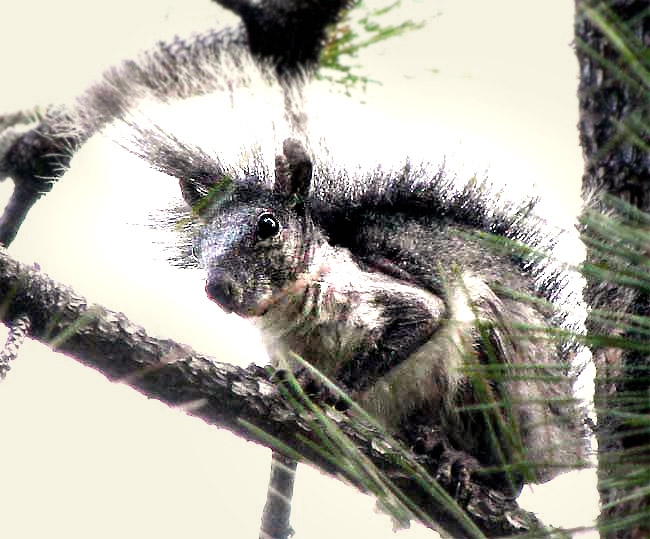Excerpts from Jim Conrad's
Naturalist Newsletter

from the April 26, 2009 Newsletter, issued from the Siskiyou Mountains west of Grants Pass, Oregon:
WIDE-EYED SQUIRREL
We have squirrels here looking a lot like the East's gray squirrels, but they strike me as a bit larger, more longer-limbed, and a good bit less trustful than those. That's him on a pine limb very excited about my presence, glaring at me wide-eyed above.
He's a Western Gray Squirrel, SCIURUS GRISEUS. Despite the Eastern and Western species being so similar, there are important differences between them. For one thing, the Eastern species has proven so adaptive to human-altered environments that it often thrives in parks and residential woodlots wherever in the temperate zone it's introduced into. Eastern Gray Squirrels are spreading throughout Europe and beyond, and even here.
Our Western Gray Squirrel is more retiring and more strictly arboreal than the Eastern species. In fact, many people in this area worry that the introduced Eastern species is displacing the native Western one. One advantage the Easterners may have is that Western Gray Squirrels produce just one litter a year while the Eastern produces two. During the 1920s Western Grays were one of the most abundant mammals in the Northwest, but during the 1930s an epidemic of mange caused a tremendous die-off.
from the June 5, 2005 Newsletter, issued from the Sierra Nevada Foothills east of Sacramento, California:
SEVEN SQUIRRELS
Biking back from my hike in El Dorado National Forest, on a small, paved road along which homes clustered about as densely as possible without being referred to as an urban zone, I came upon seven gray squirrels bounding up the middle of the road, one after the other. At first my approach on the bike didn't seem to register to them. Finally when I was about ten feet away the lead squirrel stood up and stared at me, looked confused, then scurried to the side of the road, with the others following and showing just as much indecision.
Well, this was interesting. Field guides speak of Western Gray Squirrel litter size as being 3-5, and of populations varying from two squirrels per acre to one squirrel for ten acres, so seven squirrels in the middle of a road makes no sense. I've heard of mass migrations of Eastern Gray Squirrels, so there's clearly repertory in the squirrel-behavior closet field guides and websites don't refer to.
Later I realized that what I was seeing probably was a group of males following a female. Sometimes these slow-moving "chases" last for hours, one male after another giving up, often with the last remaining male getting to mate.